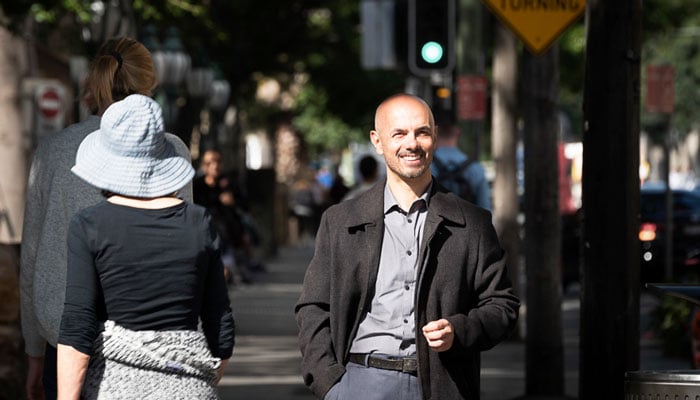“I’m too tired to go to the gym”, “I never have time to exercise”, “Going for a run just takes too long” – there are many reasons why people don’t manage to move more each day. Whether people say they can’t find the time – or policy environments make it hard to find the time – staying active is a challenge. But what if you could reduce your risk of cancer, and other diseases, with just 3 and a half minutes of activity a day; less than the time it takes to get dressed, make a coffee or – for some of us – go to the toilet?
Until recently, there has been a lack of research on exercise as incidental activity, meaning the normal things we do in our lives such as walk up the stairs, rather than when we set aside time to exercise.
So, Prof Emmanuel Stamatakis and his team at the University of Sydney looked at short bursts of exercise, also known as exercise snacking, which they termed: Vigorous Intermittent Lifestyle Physical Activity (VILPA).

In this case, “vigorous” means anything that raises your heartbeat, makes you sweat or makes you start to feel out of breath. One benefit of vigorous over moderate activity is that it is much more time efficient.
Early results from Prof Stamatakis’s VILPA research showed promising findings on short bouts of vigorous activity, which indicated that very small doses may be associated with substantial cancer risk reductions.
Getting vigorous at home
The research team then looked specifically at VILPA and cancer incidence among people who didn’t exercise, and who felt that traditional exercise may be unappealing or inaccessible. Participants wore accelerometers (devices that measured their speed and movement) on their wrist for a week. People in the study had already self-reported that they didn’t do any exercise, or go for walks in their spare time.
Even though participants weren’t doing any structured exercise, about 94% of them recorded some VILPA, and 92% of the activity was done in very short bursts lasting up to 1 minute. These bursts included power walking, climbing the stairs, carrying heavy shopping, vigorous housework or gardening, or energetic playing with children.
The findings were dramatic in showing how even tiny amounts of vigorous activity can have a significant reduction in cancer risk:
- 3.5 minutes per day was associated with a 17–18% reduction in total cancer risk compared with no vigorous activity.
- Half the participants did at least 4.5 minutes a day and this amount – less than 5 minutes of vigorous exercise – was associated with a 20–21% reduction in total cancer risk.
Cancers linked to physical activity

Some cancers are known to be related to physical activity, or lack of activity. World Cancer Research Fund has strong evidence of a link with colorectal and pre-menopausal breast cancers, and limited evidence of a link with lung cancer. And for these cancers, Prof Stamatakis found an even stronger link:
- 3.5 minutes of VILPA per day was associated with a 28–29% reduction in risk for these 3 cancers.
- 4.5 minutes of VILPA per day was associated with a 31–32% reduction in risk for these 3 cancers.
Prof Stamatakis says:
For both total cancer and physical activity-related cancers, the results clearly show the age-old adage ‘the more the better’ also applies to doing day-to-day physical activity that makes you huff and puff.
The importance of these findings is not just the strength of the link between vigorous activity and reduced cancer risk. It’s also that, for many people, short bursts of exercise are far more achievable than a lengthy session in the gym.
Prof Stamatakis adds:
“VILPA certainly has many feasibility advantages, compared with structured leisure-time exercise. We should not forget that the large majority of middle-aged and older adults, more than 70–80% in most countries, are not regular exercisers in leisure time, or simply never do any exercise. For this reason, we need to better understand how people can benefit from incidental physical activity that occurs during daily routines.”
Our study’s findings are especially pertinent to people who are not willing or keen on leisure-time exercise, which is the majority of the adult population.
The main take-home message is that moving more at a higher intensity during daily living may be a good alternative to structured exercise, and may reduce overall cancer risk in the long term.
More research is needed to understand incidental physical activity better. Studies where participants wear devices to record their activity typically lump exercise and incidental activity together, but this is not always helpful as motivation for, or barriers to, exercising in leisure time are different to, say, active travel or occupational activity.
In addition to Prof Stamatakis’s observational study, other research has looked at the underlying biological mechanisms that may explain his findings. Other trials have shown that VILPA leads to rapid improvements in cardiorespiratory fitness. Cardiorespiratory fitness is linked to less insulin resistance and less chronic inflammation, both of which are major risk factors for cancer.
> Read more about Prof Stamatakis’s research
> Follow Prof Stamatakis on Twitter
Cancer Prevention Action Week
Join us on 19-25 February 2024 for Cancer Prevention Action Week – our annual campaign focusing on ways you can make a difference and reduce your cancer risk, as well as helping your friends and family too. This year, we’re focusing on surprising, new and unexpected ways to be more active in your daily life.
> Find out more

